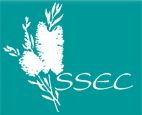Endangered Species |
Within the Kurnell Peninsula, there are a number of endangered and threatened species including the Green and Golden Bell Frog and the Little Tern.
There are also a number of Endangered Ecological Communities determined under the Threatened Species Conservation Act by the NSW Scientific Committee.
Sutherland Shire Littoral Rainforest
Littoral rainforest is a closed canopy forest characterised by trees, shrubs and vines. It is distinct from open sclerophyll forests in the Shire. Species listed in the Endangered Ecological Community occur within the terrestrial areas of Towra Point Nature Reserve (below) and in Botany Bay National Park. |
 |
Species such as Acmena Smithii (lillypilly) and Syzygium paniculatum (magenta brush cherry) occur in this stand and are extremely rare in the Sydney region. The integrity of stands of littoral rainforest is threatened by weed invasion. In 1998-99, Sutherland Shire Environment Centre was successful in obtaining a grant from Coastcare to undertake restoration of the littoral rainforest at Towra. Click here for more details about this project.
Shorebirds of Taren Point |
 |
The Taren Point Shorebird Community is the community of shorebirds (also known as waders) that only occurs on the mudflats of the Georges River between Taren Point and Shell Point in Botany Bay. The habitat and shorebirds have been studied and awareness raised about them by the Taren Point Wetlands group who were instrumental in pushing for the listing. With assistance from Kurnell Regional Environment Planning Council, the significance of the area has been highlighted and its profile raised. Indeed, in a new Draft Plan of Management for Towra Point Nature Reserve, National Parks and Wildlife Service recommended that efforts be made to incorporate Taren Point into the Ramsar wetlands of the Nature Reserve.
The Taren Point Shorebird Community is unique in Botany Bay due to the occurrence of the Terek Sandpiper which is considered to be a vulnerable species; and supports a greater number of the small mudflat feeding shorebirds such as Red-necked stint, Ruddy Turnstone, Red Knot, Curlew Sandpiper, Pacific Golden Plover and Grey-tailed Tattler.
The habitats adjacent to the area utilised by this shorebird community (i.e. Towra Point Nature Reserve) are of different geomorphological origin and do not provide alternative habitat for the Taren Point Shorebird Community. The shorebird community is under constant pressure from development in Botany Bay and the associated alteration to the natural processes within Botany Bay poses significant threats.
Kurnell Dune Forest
The major occurrence of Kurnell Dune Forest on the Peninsula is on Calsil Dune. The Forest is characterised by low open sclerophyll forest distinctive by its location on sand and its association with sclerophyll heath and scrub. Species include (but are not limited to) the Coastal Banksia, Bangalay, Coast Teatree and Cupania. The communities of plants have been reduced by clearing and development and are affected by weed invasion. To combat this, Council have released biological controls and have undertaken aerial spraying of weeds in the vicinity of the Kurnell Dune Forest. Unfortunately, during the laying of pipelines for the upgrade of the Cronulla Sewage Treatment Plant, some Kurnell Dune Forest was damaged and cleared and work was halted for a period by the State Government.
Sydney Coastal Estuary Swamp Forest and Sydney Freshwater Wetlands
The Estuary Swamp Forest is a combination of different species types which occur on estuarine alluvial soils. The influence of poor drainage conditions is a feature of the community which is hence often waterlogged. The different species types include forest, scrub, reeds, waterferns.
Some of the species found in the Swamp Forest on the Peninsula include Coastal wattle, Bangalay, Swamp She Oak, Cabbage Tree Palm, Bracken Fern (below), Gristle Fern, Common Reed, and Cattail. Many of these species can be found in Botany Bay National Park and in Marton Park.
In the freshwater wetlands the plant community is characterised by a range of species similar to those above but they occur within freshwater swamps in swales and sand dunes at Potter Point, Marton Park and Botany Bay National Park. |
 |
It has been deemed necessary to consider listing these collections of species as endangered ecological communities due to their limited occurrence and relatively small size (much has been cleared and filled for playing fields, car parks and roads) as well as the extent of disturbances. Indeed, in 1945 Council acquired a triangular shaped block of marshland between Captain Cook Drive, Solander Street and Cook Street in Kurnell, and reclaimed a portion of it by draining it and filling it with rubble and soil to form what today is Marton Park.
The collections of species that remain are threatened by waste filling, clearing as a result of urban development, urban runoff and weed invasion. The Marton Park wetlands are affected by weeds such as lantana, bitou bush and Green Cestrum.
Botany Bay Bearded Greenhood Orchid
This is a terrestrial orchid which grows up to 20cm high with slender flowering stem and single green (transparent) flower. It is listed as an Endangered Species under both the NSW Threatened Species Conservation Act and under the Federal Act. It is believed that Kurnell is the only location in NSW for the bearded greenhood orchid. It is known to occur adjacent to one of a number of fire trails in Botany Bay National Park in numbers less than 150.
In September 2000, National Parks and Wildlife Service produced a recovery plan to protect and maintain the existing vulnerable population. In addition, specific management of habitat will encourage natural regeneration of the orchid.
You can view the full online (PDF) version of the Recovery Plan including a photo of the orchid here.
Grey-headed Flying Fox
This flying fox is known to roost on parts of the Kurnell Peninsula especially on its migration along the NSW coast. |
| top of page |



